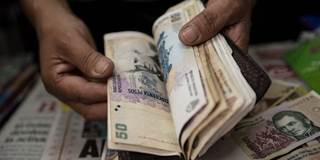Brazil invests little and is running a fiscal deficit of 9% of GDP, whereas Argentina invests more and is gradually consolidating its public finances. So why is Argentina the one that's in trouble with the currency markets?
SANTIAGO – Imagine two countries. Country A has a fiscal deficit of slightly over 5% of GDP, while country B shows a gaping hole of nearly 9%. Moreover, until recently A’s public debt barely exceeded 50% of GDP, while B’s public debt has been shooting up and will soon reach 90% of domestic output.
Of the two, B is more likely to suffer a currency crisis, right?
Not quite. A is Argentina, and B is Brazil. Since the beginning of 2018, the Argentine peso has lost half of its value. Nearly out of foreign exchange, Argentina had to adopt austerity measures to secure a $50 billion bailout from the International Monetary Fund – and not even that has calmed investors. Meanwhile, the Brazilian real has weakened, mostly in response to the uncertain outcome of the October presidential election, but no obvious financial crunch looms.

SANTIAGO – Imagine two countries. Country A has a fiscal deficit of slightly over 5% of GDP, while country B shows a gaping hole of nearly 9%. Moreover, until recently A’s public debt barely exceeded 50% of GDP, while B’s public debt has been shooting up and will soon reach 90% of domestic output.
Of the two, B is more likely to suffer a currency crisis, right?
Not quite. A is Argentina, and B is Brazil. Since the beginning of 2018, the Argentine peso has lost half of its value. Nearly out of foreign exchange, Argentina had to adopt austerity measures to secure a $50 billion bailout from the International Monetary Fund – and not even that has calmed investors. Meanwhile, the Brazilian real has weakened, mostly in response to the uncertain outcome of the October presidential election, but no obvious financial crunch looms.